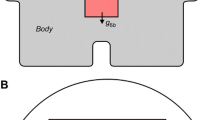Abstract
The automatic control system for brain tissue temperature is studied theoretically for brain hypothermia treatment. In order to realize a human-friendly control mechanism, an automatic temperature regulation system is constructed to simulate brain hypothermia treatment by introducing a fuzzy algorithm for possible characteristic changes in patients. The brain temperature model is successfully realized to follow the desired temperature course automatically. The model reference fuzzy control of brain temperature based on water-cooling blankets is verified for clinical application to brain hypothermia treatments through various kinds of simulation experiment.
Similar content being viewed by others
Explore related subjects
Discover the latest articles, news and stories from top researchers in related subjects.References
N Hayashi (1995) Cerebral hypothermia treatment (in Japanese) N Hayashi (Eds) Cerebral hypothermia treatment Sogo Igaku Tokyo 1–105
N Hayashi (2000) The clinical issue and effectiveness of brain hypothermia treatment for severely brain-injured patients N Hayashi (Eds) Brain hypothermia Springer Tokyo 121–151
T Obashi M Fukushi N Umeno et al. (1998) Nursing in brain hypothermia treatment (in Japanese) T Yamamoto A Teramoto (Eds) Brain hypothermia treatment Herusu Press Tokyo 124–146
Gaohua Lu H Wakamatsu (2003) ArticleTitleStudy on control of brain temperature for brain hypothermia treatment (in Japanese) IEEJ Trans EIS 123 1393–1401 Occurrence Handle10.1541/ieejeiss.123.1393
H Wakamatsu Lu Gaohua (2003) ArticleTitleAutomatic adaptive control system of brain temperature for brain hypothermia treatment (in Japanese) Brain Death Resuscitation 15 25–33
H Wakamatsu Lu Gaohua (2003) ArticleTitleBiothermal model of patient and automatic control system of brain temperature for brain hypothermia treatment (in Japanese) IEEJ Trans EIS 123 734–741 Occurrence Handle10.1541/ieejeiss.123.734
H Wakamatsu Lu Gaohua (2004) ArticleTitleAdaptive control of brain temperature for brain hypothermia treatment using the Stolwijk–Hardy model J Artif Life Robotics 8 214–221 Occurrence Handle10.1007/s10015-004-0310-z
Wakamatsu H, Lu Gaohua, Utsuki T (2004) Automatic optimal–adaptive control of brain temperature by water-cooling system. Proceedings of the 6th Asia–Pacific Conference on Control Measures (APCCM2004), China Aviation Industry Press, Nanjing, pp 22–27
H Wakamatsu T Utsuki (2004) ArticleTitleFeasibility of automatic control system for hypothermia treatment (in Japanese) Jpn J Appl Physiol 34 229–238
Wakamatsu H, Lu Gaohua (2002) Model reference adaptive control of brain temperature for cerebral hypothermia treatment. Proceedings of the 5th Asia–Pacific Conference on Control Measures (APCCM2002), China Aviation Industry Press, Nanjing, pp 1–6
Wakamatsu H Lu Gaohua (2004) ArticleTitleSimulator of automatic control of brain temperature for brain hypothermia treatment (in Japanese) Brain Death Resuscitation 16 62–68
H Wakamatsu Lu Gaohua (2003) ArticleTitleBiothermal model of patient for brain hypothermia treatment (in Japanese) IEEJ Trans EIS 123 1537–1546 Occurrence Handle10.1541/ieejeiss.123.1537
Wakamatsu H, Wakatsuki T, Utsuki T (2005) Model reference fuzzy control system of brain temperature for hypothermia treatment. Proceedings of the 16th International Federation Automatic Control, Fr-A03-TP/11(Paper Code)
H Xu H Wakamatsu S Kagei et al. (1996) ArticleTitleControl of artificial respiration with regard to difference of individuals using fuzzy algorithm (in Japanese) IEEJ Trans EIS 116 472–478
J Werner P Webb (1993) ArticleTitleA six-cylinder model of human thermoregulation for general use on personal computers Ann Physiol Anthrop 12 123–134
Z Lou WJ Yang (1990) ArticleTitleWhole body heat balance during human thoracic hyperthermia Med Biol Eng Comput 28 171–181 Occurrence Handle10.1007/BF02441774
D Fiala KJ Lomas M Stohrer (2001) ArticleTitleComputer prediction of human thermoregulatory and temperature responses to a wide range of environmental conditions Int J Biometeorol 45 143–159 Occurrence Handle10.1007/s004840100099
O Plattner A Kurz DI Sessler et al. (1997) ArticleTitleEfficacy of intraoperative cooling methods Anesthesiology 87 1089–1095 Occurrence Handle10.1097/00000542-199711000-00013
Author information
Authors and Affiliations
Corresponding author
Additional information
Partly presented at the 16th IFAC World Congress, Prague, July 2005
About this article
Cite this article
Wakamatsu, H., Wakatsuki, T. & Utsuki, T. Comparison of fuzzy control systems for hypothermal brain temperature regulation. Artif Life Robotics 11, 183–189 (2007). https://doi.org/10.1007/s10015-007-0426-z
Received:
Accepted:
Published:
Issue Date:
DOI: https://doi.org/10.1007/s10015-007-0426-z




